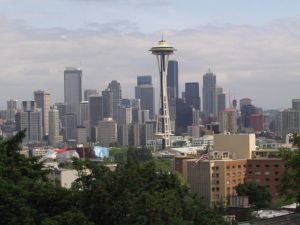When the Seattle City Council voted three years ago to raise the city’s minimum wage, analysts on both sides of the debate weighed in, predicting either a stronger economy or the loss of low-income jobs as employers dealt with the higher wages.

The Seattle skyline. From Wikimedia Commons. Used under CC BY-SA 3.0.
In recent weeks one study has made a big splash with many news outlets. A working paper by researchers at the University of Washington found a $100 million decline per year in total payroll for low-wage jobs and a nine percent drop in hours worked for jobs paying less than $19 an hour.
Just those two findings were enough to pick up headlines across the country as other cities and states consider raising their minimum wage levels above the federal minimum wage rate of $7.25. In recent years, advocates have pushed for an increase to $15.
The University of Washington study considered the overall market, and “[did] not necessarily reveal the full effect of the minimum wage increases on individual workers.” The study focused on Seattle, explaining that the results were unique to that city and its minimum wage laws. The authors also noted that they will continue with additional analyses on other characteristics of employees and how the higher minimum wage has affected them.
Prior to the University of Washington study, a similar report from the University of California at Berkeley’s Institute for Research on Labor and Employment found differing results. The report, which utilized data from the U.S. Bureau of Labor Statistics, looked primarily at the food service industry, which employs a large amount of minimum wage workers, and found employment effects that “were not statistically distinguishable from zero.”
While that’s a big takeaway, it’s important to note that the University of Washington study looked at data from all low-wage employees, not just the food services industry, and used data from the State of Washington Employment Security Department (ESD) that included hours worked by employees.
Neither study can be seen as the final word on the minimum wage debate, especially given that the minimum wage for all Seattle workers will not reach $15 an hour until 2021. Smaller companies have a longer period to wait before employees will all be at $15 an hour.
In the meantime, the debate over raising the minimum wage continues, with Minnesota being one of latest states or municipalities adopting a higher minimum wage.
“The economics behind a minimum wage increase are complicated,” said Dr. Clifford A. Lipscomb, Vice Chairman and Co-Managing Director of Greenfield Advisors. “The effects of the minimum wage, specifically in Seattle, will become clearer in the coming years as more data are collected and analyzed and as firms have time to adjust hiring practices, resulting in a new labor market equilibrium. Even as the minimum wage increases across the country, primarily to keep up with increases in the cost of living, data that will be most useful will be data at the smallest level of geography possible, as micro-market movements are sometimes not revealed by macroeconomic data.”






Recent Comments